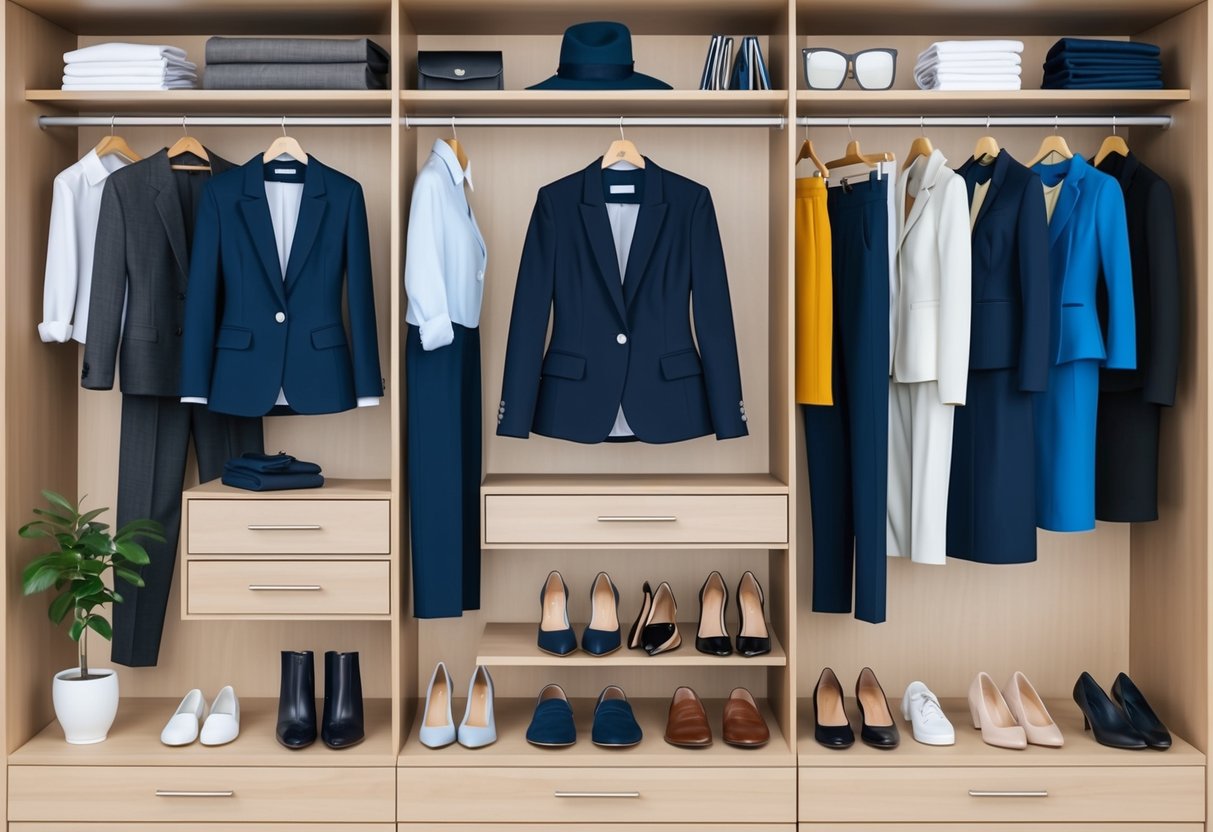
Building a versatile workwear wardrobe is easier than it may seem. A carefully curated selection of comfortable, professional, and stylish pieces allows anyone to dress with confidence, save time in the mornings, and make a polished impression in any office setting.
The right wardrobe can simplify daily outfit choices while reflecting personal style and meeting workplace expectations.
For professionals who want to balance looking chic with feeling at ease, it’s important to focus on classic essentials and high-quality fabrics that mix and match effortlessly.
Choosing items that can work across seasons and fit into various office dress codes helps keep a workwear closet both fresh and practical.
With a thoughtful approach and some expert tips, anyone can develop a work capsule wardrobe that feels modern, sophisticated, and totally wearable every day.
Understanding Workwear Wardrobe Fundamentals
A complete work wardrobe balances modern trends with workplace practicality. Each component—from basics to statement pieces—should support daily comfort while ensuring a professional appearance in any work setting.
Defining a Modern Professional Wardrobe
A modern professional wardrobe moves beyond traditional suits and pencil skirts. It prioritizes comfort, functionality, and versatility while respecting workplace expectations.
Employees often combine tailored separates like blazers and wide-leg trousers with premium basics such as knit tops or button-down shirts.
Subtle patterns, minimalist accessories, and neutral tones create a polished look adaptable to different roles and industries.
Quality over quantity is key. Investing in well-made pieces means less frequent replacements, making the wardrobe more sustainable.
Stretch fabrics, breathable materials, and adjustable fits enhance comfort throughout long workdays.
Identifying Key Work Essentials
There are certain items that consistently form the backbone of an effective workwear wardrobe.
Common work essentials include:
- Blazers (in black, navy, or gray)
- Tailored pants
- Classic blouses or shirts
- Comfortable flats or loafers
- Smart knitwear
For variety, include a mix of skirts and dresses in easy-care fabrics.
Each item should mix and match with others to create multiple outfit combinations.
Layering pieces—like cardigans or vests—add flexibility for fluctuations in office temperatures.
Consider the climate and commute. Materials such as wool-blends for winter or breathable cottons for warm offices can greatly improve daily comfort.
A professional wardrobe should also allow easy transitions from office meetings to after-hours events.
Navigating Dress Codes and Professional Settings
Understanding the workplace dress code is critical for curating a workwear wardrobe that aligns with company policies and expectations.
Dress codes generally fall into categories such as business formal, business casual, and smart casual.
Examples of dress codes include:
- Business formal: matching suits, dress shirts, closed-toe shoes
- Business casual: separates, patterned blouses, clean sneakers or loafers
- Smart casual: dark jeans, blazers, polished tees
Reading the employee handbook or observing how colleagues dress can clarify any unspoken rules.
Aligning outfits with the company culture fosters credibility and ensures one never feels out of place, as emphasized in this guide to curating a workwear wardrobe.
Always prioritize neatness, fit, and appropriateness for the day’s specific professional setting.
Building Your Work Capsule Wardrobe
Creating a work capsule wardrobe is a smart way to dress with efficiency, professionalism, and comfort throughout the workweek.
Selecting a minimal but versatile range of clothing allows for seamless outfit planning and ensures all pieces pair well together.
Benefits of a Capsule Approach
A capsule wardrobe for work limits the number of items in the closet, focusing on high-quality essentials that fit the office dress code and personal style.
This approach reduces decision fatigue in the morning and simplifies getting dressed.
By investing in fewer, well-chosen pieces, it becomes easier to maintain clothes, identify gaps in the wardrobe, and spend less on unnecessary items.
Capsule wardrobes typically allow for more thoughtful shopping and improved sustainability.
Having a core set of timeless pieces, such as tailored trousers or versatile blouses, helps create a strong foundation.
A typical formula might include 10–30 mix and match items for endless combinations, as outlined in detailed guides like this one.
Selecting Versatile Pieces
Selecting pieces for a work capsule wardrobe begins with identifying the essentials.
Key categories include 2–3 pairs of well-fitting trousers or skirts, several neutral blouses or tops, 1–2 blazers or cardigans, and 2–3 pairs of shoes suitable for the office.
Neutral colors such as black, navy, beige, and white tend to maximize versatility and pair well with other items.
It’s important to focus on materials that are comfortable, machine-washable, and suited to the work environment.
A table of must-have work capsule wardrobe items might look like this:
| Item | Quantity | Notes |
|---|---|---|
| Trousers/Skirts | 2–3 | Neutral, tailored fit |
| Tops/Blouses | 3–5 | Varying sleeve lengths |
| Blazer/Cardigan | 1–2 | Layering for formality |
| Shoes | 2–3 | Flats, loafers, or low heels |
| Dress | 1–2 | Simple and office-appropriate |
To ensure longevity and mixability, prioritize classic shapes and avoid fast-fashion trends.
Mix and Match Strategies
A key advantage of a work capsule wardrobe is the ability to mix and match each piece to create a variety of looks.
When every item can pair easily with others, it’s possible to create dozens of unique outfits from a limited selection.
Start by ensuring that the majority of items share a color palette.
Choosing patterns or textures that coordinate—such as pinstripes or subtle prints—adds visual interest while keeping combinations professional.
Accessories like scarves, belts, or minimalist jewelry can also refresh basic looks without adding bulk to the wardrobe.
Practical outfit templates, such as “trouser + blouse + blazer” or “dress + cardigan,” simplify daily outfit planning.
For more examples of how to build and pair capsule modules, visit this guide.
With thoughtful planning, a curated capsule can meet both style and practical needs in any workplace.



